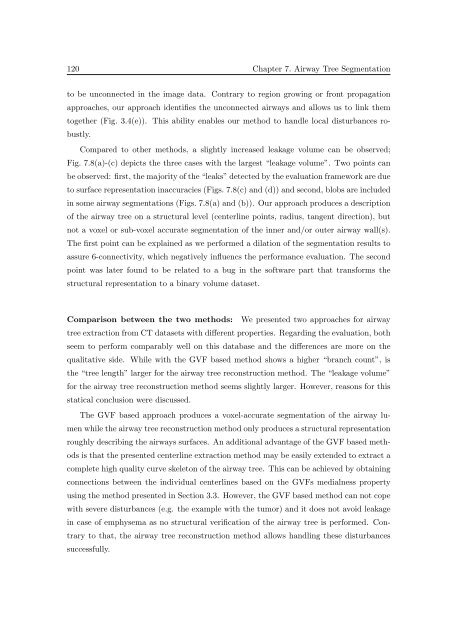Segmentation of 3D Tubular Tree Structures in Medical Images ...
Segmentation of 3D Tubular Tree Structures in Medical Images ...
Segmentation of 3D Tubular Tree Structures in Medical Images ...
Create successful ePaper yourself
Turn your PDF publications into a flip-book with our unique Google optimized e-Paper software.
120 Chapter 7. Airway <strong>Tree</strong> <strong>Segmentation</strong><br />
to be unconnected <strong>in</strong> the image data. Contrary to region grow<strong>in</strong>g or front propagation<br />
approaches, our approach identifies the unconnected airways and allows us to l<strong>in</strong>k them<br />
together (Fig. 3.4(e)). This ability enables our method to handle local disturbances robustly.<br />
Compared to other methods, a slightly <strong>in</strong>creased leakage volume can be observed;<br />
Fig. 7.8(a)-(c) depicts the three cases with the largest “leakage volume”. Two po<strong>in</strong>ts can<br />
be observed: first, the majority <strong>of</strong> the “leaks” detected by the evaluation framework are due<br />
to surface representation <strong>in</strong>accuracies (Figs. 7.8(c) and (d)) and second, blobs are <strong>in</strong>cluded<br />
<strong>in</strong> some airway segmentations (Figs. 7.8(a) and (b)). Our approach produces a description<br />
<strong>of</strong> the airway tree on a structural level (centerl<strong>in</strong>e po<strong>in</strong>ts, radius, tangent direction), but<br />
not a voxel or sub-voxel accurate segmentation <strong>of</strong> the <strong>in</strong>ner and/or outer airway wall(s).<br />
The first po<strong>in</strong>t can be expla<strong>in</strong>ed as we performed a dilation <strong>of</strong> the segmentation results to<br />
assure 6-connectivity, which negatively <strong>in</strong>fluencs the performance evaluation. The second<br />
po<strong>in</strong>t was later found to be related to a bug <strong>in</strong> the s<strong>of</strong>tware part that transforms the<br />
structural representation to a b<strong>in</strong>ary volume dataset.<br />
Comparison between the two methods: We presented two approaches for airway<br />
tree extraction from CT datasets with different properties. Regard<strong>in</strong>g the evaluation, both<br />
seem to perform comparably well on this database and the differences are more on the<br />
qualitative side. While with the GVF based method shows a higher “branch count”, is<br />
the “tree length” larger for the airway tree reconstruction method. The “leakage volume”<br />
for the airway tree reconstruction method seems slightly larger. However, reasons for this<br />
statical conclusion were discussed.<br />
The GVF based approach produces a voxel-accurate segmentation <strong>of</strong> the airway lumen<br />
while the airway tree reconstruction method only produces a structural representation<br />
roughly describ<strong>in</strong>g the airways surfaces. An additional advantage <strong>of</strong> the GVF based methods<br />
is that the presented centerl<strong>in</strong>e extraction method may be easily extended to extract a<br />
complete high quality curve skeleton <strong>of</strong> the airway tree. This can be achieved by obta<strong>in</strong><strong>in</strong>g<br />
connections between the <strong>in</strong>dividual centerl<strong>in</strong>es based on the GVFs medialness property<br />
us<strong>in</strong>g the method presented <strong>in</strong> Section 3.3. However, the GVF based method can not cope<br />
with severe disturbances (e.g. the example with the tumor) and it does not avoid leakage<br />
<strong>in</strong> case <strong>of</strong> emphysema as no structural verification <strong>of</strong> the airway tree is performed. Contrary<br />
to that, the airway tree reconstruction method allows handl<strong>in</strong>g these disturbances<br />
successfully.















